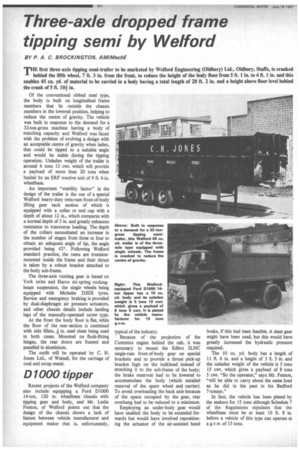Three-axle dropped frame tipping semi by Welford
Page 52

If you've noticed an error in this article please click here to report it so we can fix it.
BY P. A. C. BROCKINGTON, AMIMechE
TliE first three-axle tipping semi-trailer to be marketed by Welford Engineering (Oldbury) Ltd., Oldbury, Staffs, is cranked behind the fifth wheel, 7 ft. 3 in. from the front, to reduce the height of the body floor from 5 ft. 1 in. to 4 ft. tin, and this enables 45 cu. yd. of material to be carried in a body having a total length of 28 ft. 2 in. and a height above floor level behind the crank of 5 ft. 101 in.
Of the conventional ribbed steel type, the body is built on longitudinal frame members that tie outside the chassis members in the lowered position, helping to reduce the centre of gravity. The vehicle was built in response to the demand for a 32-ton-gross machine having a body of matching capacity and Welford was faced with the problem of evolving a design with an acceptable centre of gravity when laden, that could be tipped to a suitable angle and would be stable during the tipping operation. Unladen weight of the trailer is around 6 tons 12 cwt. which will provide a payload of more than 20 tons when hauled by an ERF tractive unit of 9 ft. 6 in. wheelbase.
An important "stability factor" in the design of the trailer is the use of a special Welford heavy-duty twin-ram front-of-body lifting gear each section of which is equipped with a collar or end cap with a depth of about 12 in., which compares with a normal depth of 3 in. and greatly enhances resistance to transverse loading. The depth of the collars necessitated an increase in the number of stages from three to four to obtain an adequate angle of tip, the angle provided being 42°. Following Welford standard practice, the rams are trunnionmounted inside the frame and their thrust is taken by a robust bracket attached to the body sub-frame.
The three-axle running gear is based on York axles and Harco six-spring rockingbeam suspension, the single wheels being equipped with Michelin D2OX tyres. Service and emergency braking is provided by dual-diaphragm air pressure actuators, and other chassis details include landing legs of the manually-operated screw type.
At the front the body floor is flat, while the floor of the rear-section is combined with side fillets, in. steel sheet being used in both cases. Mounted on flush-fitting hinges, the rear doors are framed and panelled in aluminium.
The outfit will be operated by C. H. Jones Ltd., of Walsall, for the carriage of coal and scrap metal.
D1000 tipper
Recent projects of the Welford company also include equipping a Ford 1)1000 14-ton, 120 in. wheelbase chassis with tipping gear and body, and Mr. Leslie Fenton, of Welford points out that the design of the chassis shows a lack of liaison between vehicle manufacturer and equipment maker that is, unfortunately, typical of the industry. Because of the projection of the Cummins engine behind the cab, it was necessary to mount the Edbro 3LNC single-ram front-of-body gear on special brackets and to provide a thrust pick-up bracket high on the bulkhead instead of attaching it to the sub-frame of the body; the brake reservoir had to be lowered to accommodate the body (which entailed removal of the spare wheel and carrier). To avoid overloading the back axle because of the space occupied by the gear, rear overhang had to be reduced to a minimum.
Employing an under-body gear would have enabled the body to be extended forwards but would have involved repositioning the actuator of the air-assisted hand brake, if this had been feasible. A slant gear might have been used, but this would have greatly increased the hydraulic pressure required.
The 10 cu. yd. body has a length of 11 ft. 6 in. and a height of 3 ft. 3 in. and the unladen weight of the vehicle is 5 tons 15 cwt. which gives a payload of 8 tons 5 cwt. "So the operator," says Mr. Fenton, "wilt be able to carry about the same load as he did in the past in his Bedford 7-tanner."
In fact, the vehicle has been plated by the makers for 15 tons although Schedule 7 of the Regulations stipulates that the wheelbase must be at least 10 ft. 8 in. before a vehicle of this type can operate at a g.v.w. of 15 tons.




































































































































